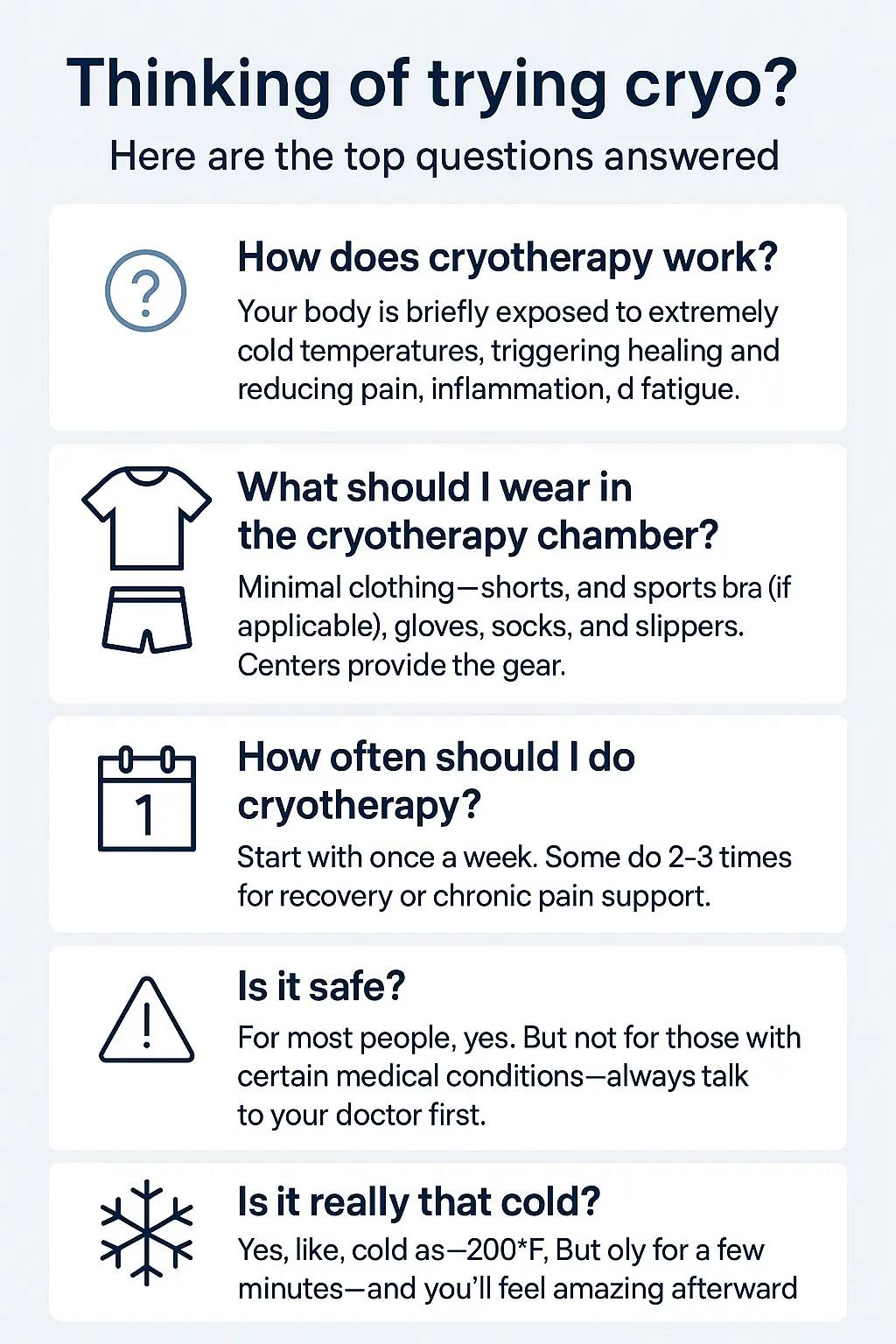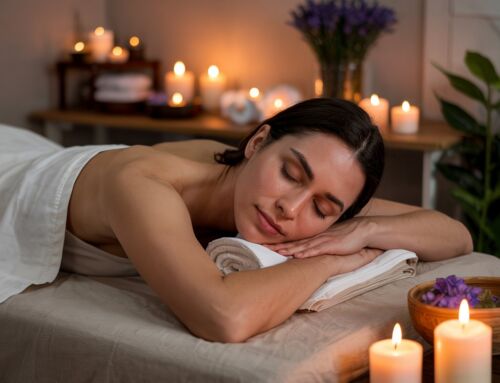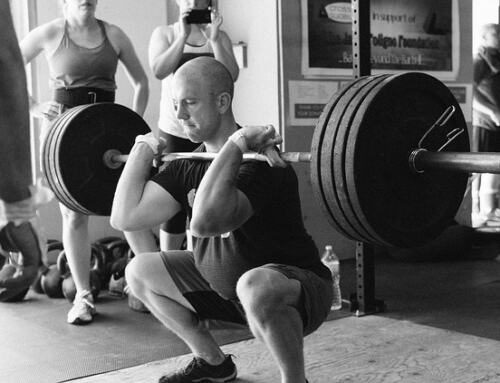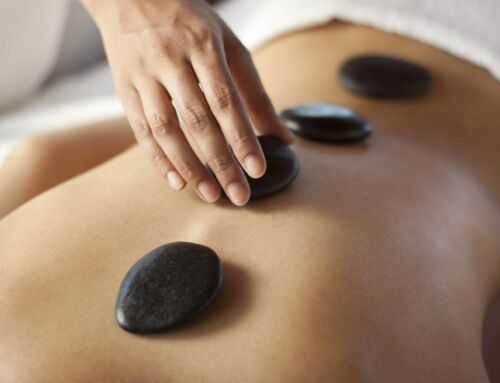Why I Tried Whole-Body Cryotherapy (and Why You Might Want to Try It Too)
I’ll be honest—I used to think cryotherapy sounded like something out of a sci-fi movie. Getting into a freezing cold chamber? On purpose? No thanks.
But then, after months of dealing with nagging muscle soreness and stress that just wouldn’t quit, I decided to give it a shot. And let me tell you, it was one of the most bizarre and refreshing things I’ve ever done for my health.
Whole-body cryotherapy isn’t just a fad. It’s a real, research-backed form of treatment that involves stepping into a chamber cooled to ultra cold temperatures—we’re talking as low as -200 degrees Fahrenheit. You stay in there for just a few minutes, but the effects can last much longer.
If you’ve ever wondered, “How does cryotherapy work?” or “Could this really help me feel better?”—you’re not alone. I had the same questions. And now, after several cryotherapy sessions, I’m here to break it all down in plain language.
Let’s dive into the cold—literally.
So, What Is Cryotherapy?
At its core, cryotherapy is all about exposing your body to extremely cold temperatures for a short amount of time. It’s not some mystical nonsense—it’s based on physiological effects that kick in when your body senses danger (like extreme cold) and reacts in a way that actually helps you heal.
There are a few different kinds, but the one I’ve tried (and the one you’ll hear about most) is whole-body cryotherapy. You step into a cryo chamber, often cooled with liquid nitrogen, and stay there for about 2–3 minutes. Yep, that’s it.
During that time, cold air swirls around you. Your skin might tingle, and your brain definitely goes, “Whoa.” But once you step out? You feel awake. Alive. Like someone flipped your internal switch.
This isn’t just about being tough. Peer-reviewed studies from academic research institutions suggest that whole-body cryotherapy can help with things like pain relief, decreased inflammation, and even improved athletic performance.
I was skeptical at first, too. But once I felt that post-cryo buzz—that weird combo of relaxed muscles and total mental clarity—I started to get it.
The Real Benefits of Cryotherapy
Let’s talk results. Because sure, standing in a cryotherapy booth at -200 degrees Fahrenheit might sound wild—but the health benefits? Totally worth it.
After a few sessions, I noticed some surprising changes. The first was how much faster my body bounced back after workouts. Normally, I’d be dealing with muscle soreness for days. But after whole-body cryotherapy, I could go hard at the gym and feel good the next morning. It was like my muscles had a fast-forward button for recovery.
And I’m not the only one. Many athletes have been using cryotherapy for years to help with post-exercise recovery and to reduce pain after intense training. It’s no magic trick—it’s just cold exposure doing its thing.
Reduced Inflammation
One of the biggest cryotherapy benefits is its ability to reduce inflammation. That’s huge. Inflammation is behind so many problems—chronic pain, joint stiffness, and even skin conditions.
I have mild rheumatoid arthritis, and while cryotherapy isn’t a cure, I swear it’s made my joints feel looser and more mobile. On the days I do a session, I move better. I sleep better. Everything just flows.
Cryotherapy can help calm down the inflammatory response, lowering those pesky inflammatory markers in your system. That’s something many peer-reviewed studies back up.
Better Mood and Mental Clarity
Now here’s something I didn’t expect: the mood lift.
After just a few minutes of being exposed to extremely cold temperatures, I feel clearheaded—like I’ve hit a mental reset. It’s hard to explain unless you’ve tried it yourself. But some researchers believe this effect is tied to the sympathetic nervous system getting a jolt from the cold, releasing feel-good hormones like endorphins.
For anyone dealing with anxiety disorders or mood disorders, that quick hit of clarity might make a world of difference. I can’t speak for everyone, but I know that for me, cryo feels like a shortcut to focus.
Immune System Boost
There’s also talk—some of it backed by academic research—that cold exposure may support the immune system. Think about it: when your body experiences subzero temperatures, it kicks into gear. That brief stress seems to train your system to respond better to other stressors.
And if you’ve ever felt like you were constantly catching colds or dragging through the day, wouldn’t you want something that could improve your health naturally?
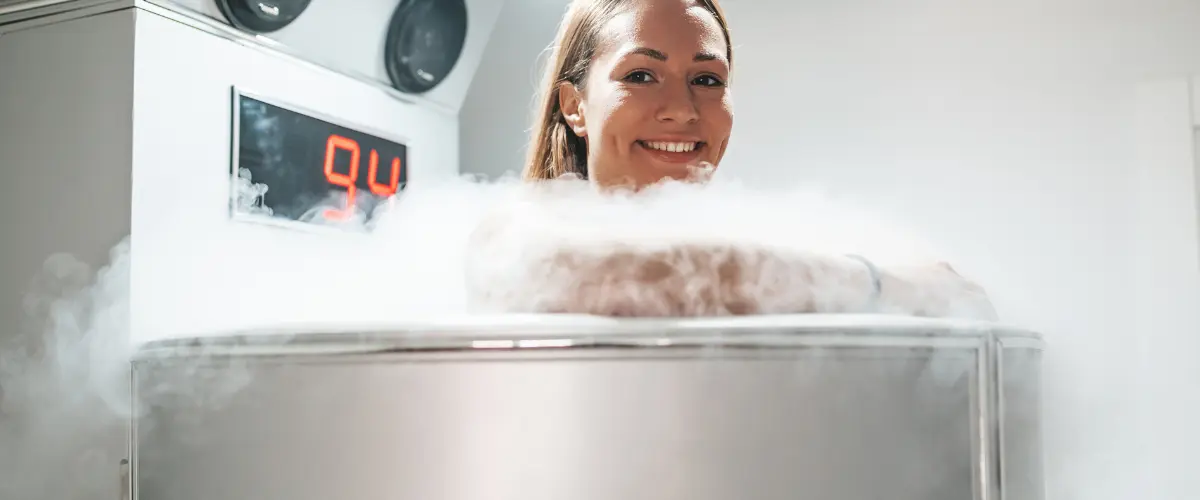
Whole Body Cryotherapy for Muscle Recovery: Why Athletes Swear by It
You ever finish a workout feeling like a superhero, only to wake up the next day feeling like you got hit by a truck? That’s delayed onset muscle soreness—or DOMS for short. It’s the kind of pain that makes you think twice about sitting down or climbing stairs.
That used to be my story, especially after leg day. But when I started doing regular cryotherapy sessions, I noticed something: the soreness didn’t stick around as long. Sometimes it barely showed up at all.
How Does Cryotherapy Help?
When you’re in the cryotherapy chamber, your body is hit with intense cold for 2 to 4 minutes. That cold does more than just make you shiver. It causes your blood vessels to constrict, reducing inflammation and slowing down nerve activity. That’s a fancy way of saying: it helps with pain relief and makes your muscles feel a whole lot better.
Once you step out of the cold, your body starts pumping oxygen-rich blood back to your tissues. That rush helps with muscle recovery, flushing out waste products like lactic acid that can cause stiffness and soreness.
Honestly, after a tough workout, there’s nothing better than stepping into that cold environment, letting it zap the fatigue right out of your legs.
Athletes Use It—But So Can You
You don’t have to be a professional athlete to benefit from cryotherapy. I’m just a regular person trying to stay active without feeling wrecked all week. But guess what? The same therapeutic benefits the pros get, you can get too.
Studies have found cryotherapy effective at improving muscle pain, reducing inflammatory markers, and supporting faster post-exercise recovery. That’s why so many sports teams and gyms now have their own cryotherapy chambers—it works.
I’ve even had days where I pushed myself harder than usual at the gym, did a cryo session afterward, and woke up feeling like I barely worked out. It’s wild.
What About Muscle Strength?
There’s also some evidence that whole-body cryotherapy might support improved muscle strength over time. That’s still being studied, but the theory is that faster recovery means you can train more consistently—without setbacks from soreness or fatigue.
Bottom line: if you’re serious about your workouts—or just trying to stay active without feeling broken—cryotherapy treatment can give you a real edge.
Relief Without the Pills
If you’ve ever reached for ibuprofen after a long day or a tough workout, you’re not alone. I used to rely on it regularly. But once I started using cryotherapy consistently, I noticed something big—I wasn’t reaching for painkillers as often.
Cryotherapy treatment has been shown to help with chronic pain and pain management by dulling nerve activity and reducing inflammation. I’m not saying it replaces every kind of medical treatment, but for me, it’s been an amazing supplement.
I have a friend who suffers from nerve damage in her shoulder. After trying whole-body cryotherapy, she told me the stabbing pain she used to feel every morning was dramatically less. It didn’t cure her, but it helped enough that she could sleep better and move more freely.
And that’s the thing—cryotherapy may not be a miracle, but when it works, it really works.
Help for Inflammatory Skin Conditions
If you deal with skin disease, you know how frustrating it can be. I’ve had bouts of eczema over the years, and sometimes topical creams just don’t cut it. That’s when I started reading about cryotherapy’s effects on chronic inflammatory skin conditions.
The theory is this: when your skin is exposed to extremely cold temperatures, it calms the inflammatory response, reduces swelling, and helps with itching. And honestly, that tracks with my own experience.
Some days after a session, I noticed my flare-ups would shrink faster. My skin felt less irritated, less angry. Localized cryotherapy is also an option—basically targeting specific areas instead of doing the full-body chamber—and that’s something I’m hoping to try next for those smaller patches.
People also use cryotherapy to freeze off skin tags, and there’s research into how cold temperatures may even help slow the growth of cancer cells in certain cases. Of course, cryotherapy is still considered a complementary therapy for skin issues, not a primary treatment. But if you’re dealing with stubborn conditions, it’s something worth asking your dermatologist about.
Supporting Overall Health and Wellness
Let’s zoom out for a minute.
What I love about cryotherapy is that it doesn’t just help one thing. It feels like a reset button for your physical and mental health. After a session, I feel lighter—both in my body and my head.
Some days I walk in drained, grumpy, maybe even anxious. But I leave feeling refreshed, recharged, and ready to take on the rest of my day. That’s why I think whole-body cryotherapy is as much about wellness as it is about treatment.
Regular sessions can support your immune system, help you reduce stress, and give your body a break from all the daily wear and tear. It’s like putting your body in power-save mode for a few minutes—and the positive effects last.
Even if you’re not battling a specific issue like chronic pain or rheumatoid arthritis, cryotherapy can still help you improve your health in subtle but powerful ways.
What Science Says: Cryotherapy’s Medical Roots
I didn’t know this at first, but doctors have long used cold in various forms to help the body heal. Think about ice packs—they’ve been around forever. Localized cryotherapy, which targets specific areas of the body, is essentially a high-tech version of that old-school method.
But what about whole-body cryotherapy (also called body cryotherapy WBC)? That’s where things get interesting.
Turns out, whole-body cryostimulation started in Japan in the late 1970s. It was originally used to treat rheumatoid arthritis and other painful medical conditions. Since then, it’s spread across Europe and now the U.S., becoming a trendy wellness treatment—but it actually has some deep roots in clinical practice.
Cryotherapy Is Still Evolving
Let’s be real—cryotherapy is still being studied. Some people treat it like a miracle cure, but the truth is more nuanced. That said, there’s a growing body of research showing promising results.
If you look at a review of the literature, you’ll see that peer-reviewed studies and papers from academic research institutions are digging into how cryotherapy affects inflammation, recovery, immune response, and even mental clarity.
Most experts agree that it should be seen as a complementary form of treatment—not a replacement for traditional care. It’s especially helpful when combined with physical therapy, massage, stretching, and other recovery techniques.
Used in Sports Medicine, Rehab, and Beyond
Today, whole-body cryotherapy is widely used to treat athletes after training, people recovering from surgery, and those with chronic illnesses. There are even experimental uses being tested for things like mood disorders, skin disease, and pain management.
Some guidelines and relies on peer-reviewed medical research suggest that cryo could play a role in managing inflammatory markers, reducing pain, and improving overall wellness. While we still need more data, the trend is clear—cryotherapy may be more than just a wellness craze.
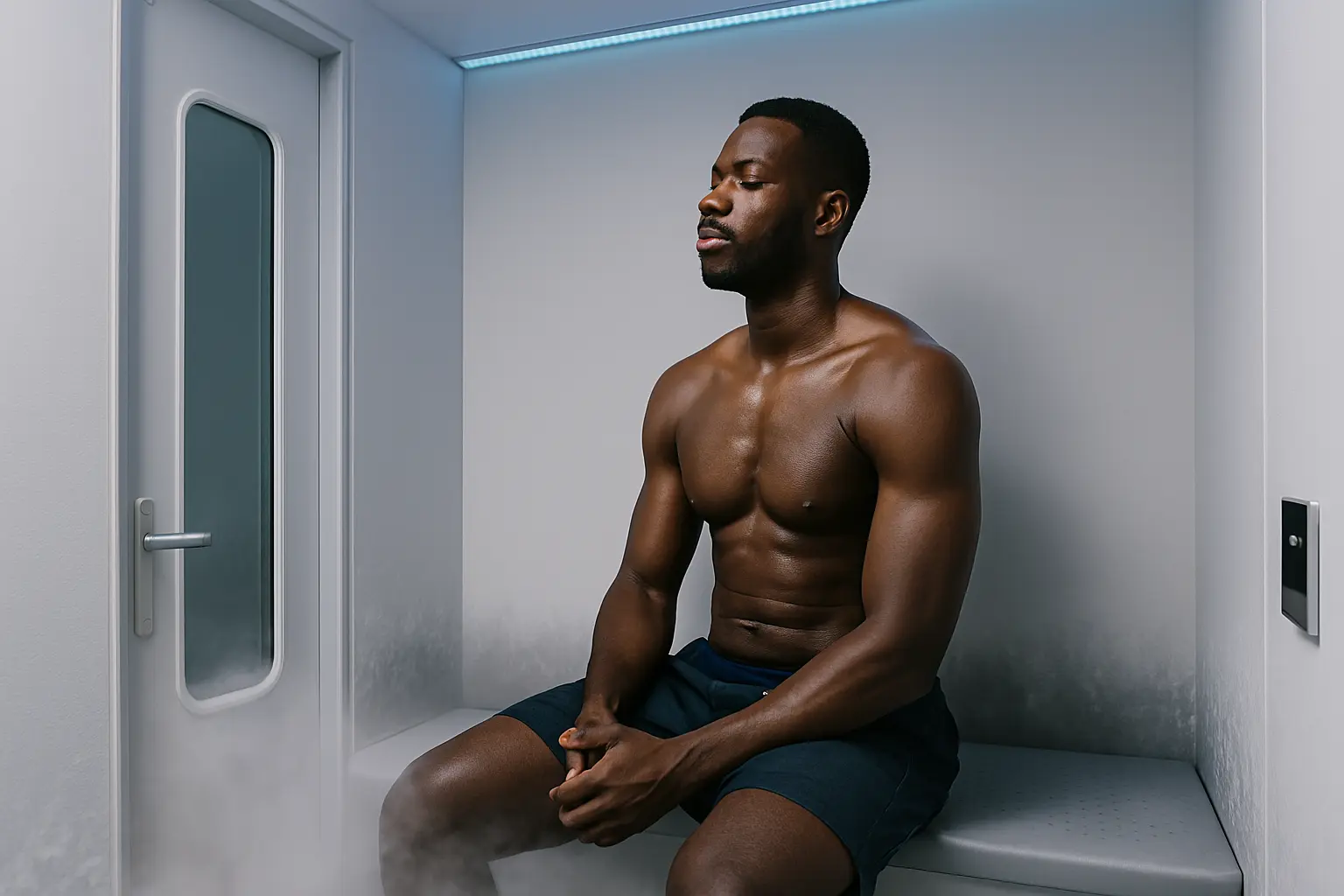
Cryotherapy Isn’t for Everyone: Risks and Red Flags
I’ll be the first to admit—cryotherapy sounds cool (literally), but it’s not all icy rainbows and unicorns. Like anything that impacts your body, it has potential risks. And if you’re thinking about trying it, you should know what you’re signing up for.
First Things First: Talk to Your Doctor
Before you hop into a cryotherapy chamber, especially if you have medical conditions, it’s smart to talk to your doctor. Cryo may seem harmless—it’s just cold, right? But it puts your body under stress, and that’s not ideal for everyone.
For example, people with heart problems, high blood pressure, or nerve damage should definitely proceed with caution. The very cold temperatures can cause your blood vessels to constrict quickly, which could trigger issues if your cardiovascular system isn’t in great shape.
Also, if you have Raynaud’s disease, cold sensitivity, or poor circulation, cryotherapy may actually make things worse.
Cryotherapy Can Cause …
Most people walk out of the chamber feeling amazing. But every now and then, someone might experience side effects. Some of the more common ones include:
- Numbness or tingling
- Redness or skin irritation
- Dizziness or feeling lightheaded
- Frostbite (yes, it’s rare—but it has happened when people didn’t follow safety rules)
I once stayed in just a little too long—trying to be a tough guy—and ended up with slightly irritated skin on my calf for a few days. Nothing major, but it taught me to listen to the technician and not push it.
And let’s be clear: whole-body cryotherapy is not something you should do at home with a DIY setup. That’s just asking for trouble. Legit cryotherapy treatment centers are trained to monitor you, keep the time short, and make sure your cold exposure stays safe.
Pregnant? Skip It.
If you’re pregnant, cryotherapy isn’t recommended. Your body is already under stress growing a tiny human—you don’t need to throw -200 degrees Fahrenheit into the mix.
Same goes if you have a fever, infection, or open wounds. Cryo can worsen these problems or delay your healing.
Final Thoughts: Is Cryotherapy Worth It?
So, is standing in a freezing cryotherapy chamber for a few minutes really worth your time?
If you ask me—yes. A hundred times yes.
I walked into my first session feeling skeptical and a little nervous. I walked out feeling energized, lighter, and totally hooked. Since then, it’s become a regular part of my routine, right up there with stretching, sleep, and drinking water.
The benefits of cryotherapy are real—at least, they have been for me. From helping with muscle soreness and pain relief, to lifting my mood and clearing my head, the cold does more than just wake you up. It helps you heal.
Whether you’re an athlete looking for muscle recovery, someone battling chronic pain, or just curious about how to improve your health, cryotherapy can help you feel better—inside and out.
Of course, it’s not a cure-all. It’s not for everyone. And it’s not meant to replace medical advice. Cryotherapy is still being researched, and not every claim is backed by rock-solid science. But the therapeutic benefits are real enough that I keep going back.
So, if you’re even a little curious? Give it a shot.
Try cryotherapy once. See how you feel. You might just love it like I did.
